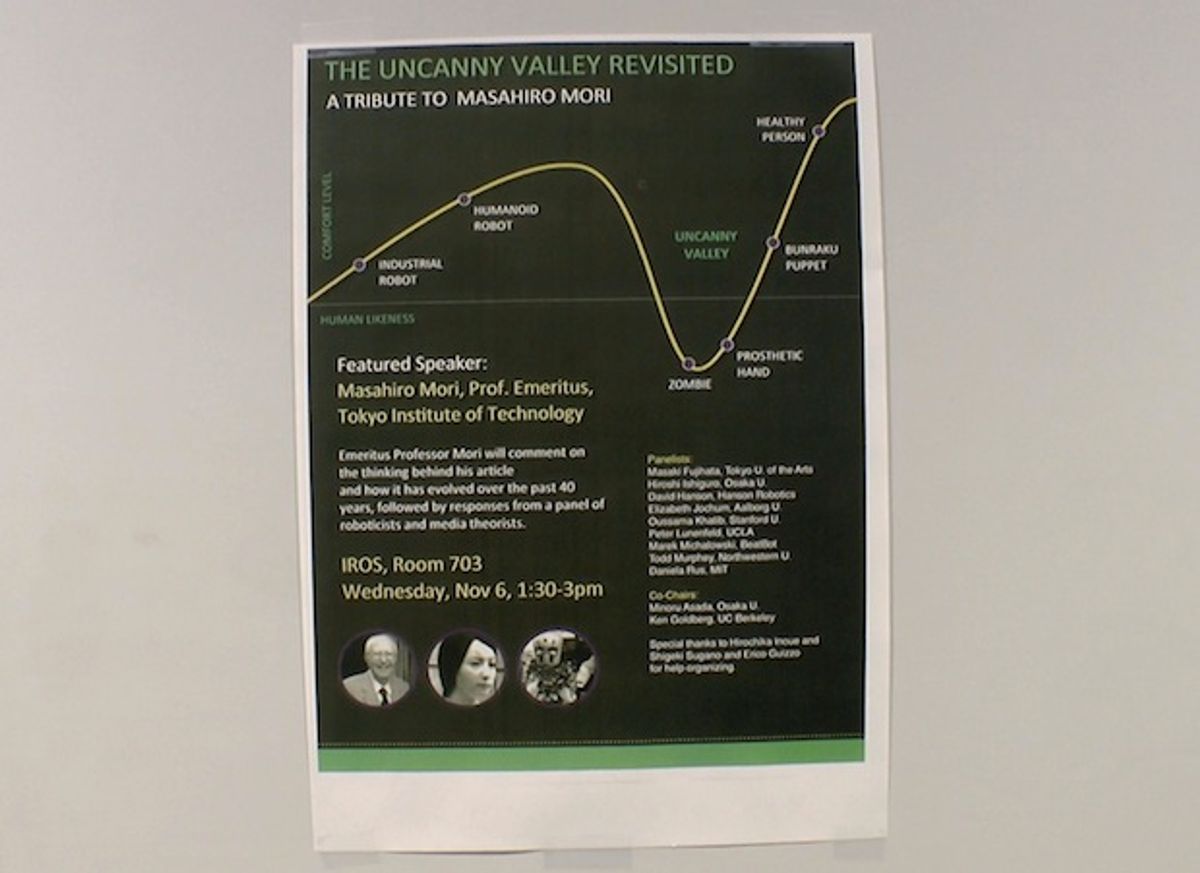A plunge into the Uncanny Valley became the most talked about event at a recent robotics conference in Japan.
Masahiro Mori, the man who proposed the concept of the Uncanny Valley more than 40 years ago, made a rare appearance at the IEEE International Conference on Intelligent Robots and Systems (IROS) in Tokyo early this month.
Attendees packed a room at the Tokyo Big Sight convention center to listen to Mori, 86, a celebrated researcher and educator whom the Japanese media calls "Dr. Robot." In his presentation, Mori, an emeritus professor at the Tokyo Institute of Technology, retraced the path that led him to the idea of Bukimi-no-Tani, which became known in English as the Uncanny Valley. The idea—an attempt to explain how people react to humanlike robots, prosthetics, and other animated entities—is encapsulated in a now-famous graph (pictured on the poster above).
Mori told the audience that while working on a robotic hand, he became interested in prosthetics. That led him to think about how people respond to different mechanical hands, and how appearance and movement play a big role in that regard. Following his intuitions, he said, he conceived the key hypothesis that our affinity toward a robot abruptly decreases when a lifelike appearance is approached but not attained. This precipitous plunge from acceptance to revulsion is the Uncanny Valley.
One point that surprised many in the audience was Mori's comment that his Uncanny Valley idea had remained "dormant" for four decades, being "awakened" in 2012, when the first English version of his paper was published in the IEEE Robotics & Automation Magazine and online in IEEE Spectrum. At least one panelist respectfully disagreed with Mori, noting that the Uncanny Valley has attracted interest in many disciplines much before that.
As for why we feel this eerie sensation when we see certain robots, androids, and CGI characters, Mori didn't speculate, saying only that there are "open questions" that science has to address. (In fact, researchers are still investigating the possible biological and social roots, seeking to put the Uncanny Valley on firmer scientific ground.) And in terms of robot design, Mori said that, instead of trying to overcome the Uncanny Valley, roboticists should avoid it altogether, building robots that have nonhuman appearance. His final advice: pay attention not only to the big picture but also to the small things and follow your intuitions.
"The Uncanny Valley Revisited: A Tribute to Masahiro Mori," organized by Ken Goldberg of UC Berkeley and Minoru Asada of Osaka University, with help from Hirochika Inoue of the University of Tokyo and Shigeki Sugano of Waseda University, included presentations by roboticists, artists, and media theorists.
From left: Hiroshi Ishiguro, Minoru Asada, Marek Michalowski, Todd Murphey, Oussama Khatib, Elizabeth Jochum, Masahiro Mori, Ken Goldberg, Noriko Kageki, Peter Lunenfeld, Hirochika Inoue, and Masaki Fujihata.
Below are all the presentations in full (and watch also some of the panelists explaining the Uncanny Valley in less than one minute):
Ken Goldberg (UC Berkeley) introduces Masahiro Mori:
Masahiro Mori, with translation by Noriko Kageki:
Masaki Fujihata (Tokyo University of the Arts):
Elizabeth Jochum (University of Copenhagen):
Peter Lunenfeld (UCLA):
Marek Michalowski (BeatBots):
Hiroshi Ishiguro (Osaka University):
Todd Murphey (Northwestern University):
Oussama Khatib (Stanford University):
Concluding remarks:
Erico Guizzo is the director of digital innovation at IEEE Spectrum, and cofounder of the IEEE Robots Guide, an award-winning interactive site about robotics. He oversees the operation, integration, and new feature development for all digital properties and platforms, including the Spectrum website, newsletters, CMS, editorial workflow systems, and analytics and AI tools. An IEEE Member, he is an electrical engineer by training and has a master’s degree in science writing from MIT.




